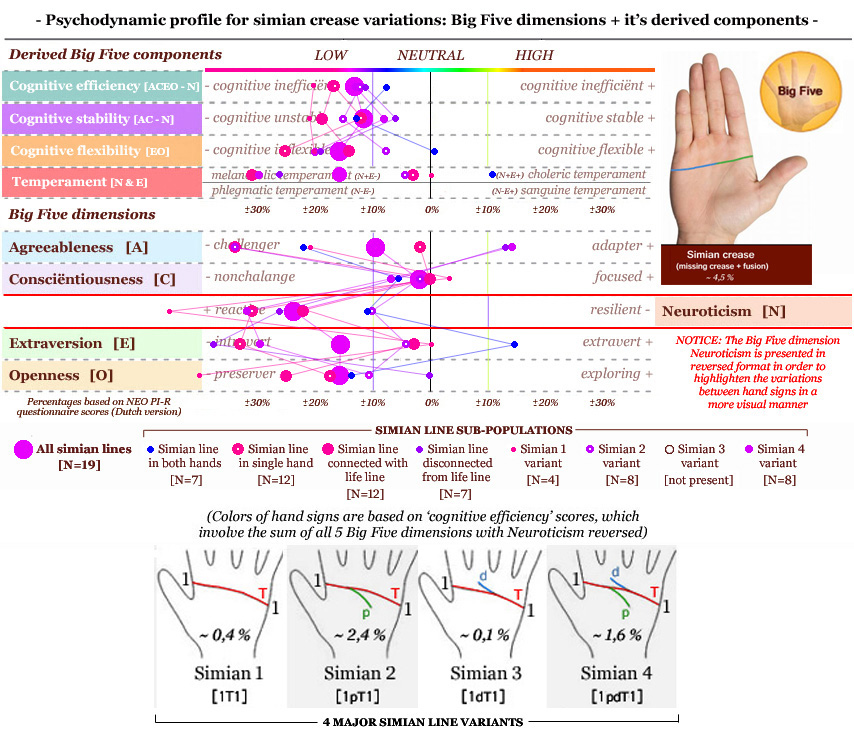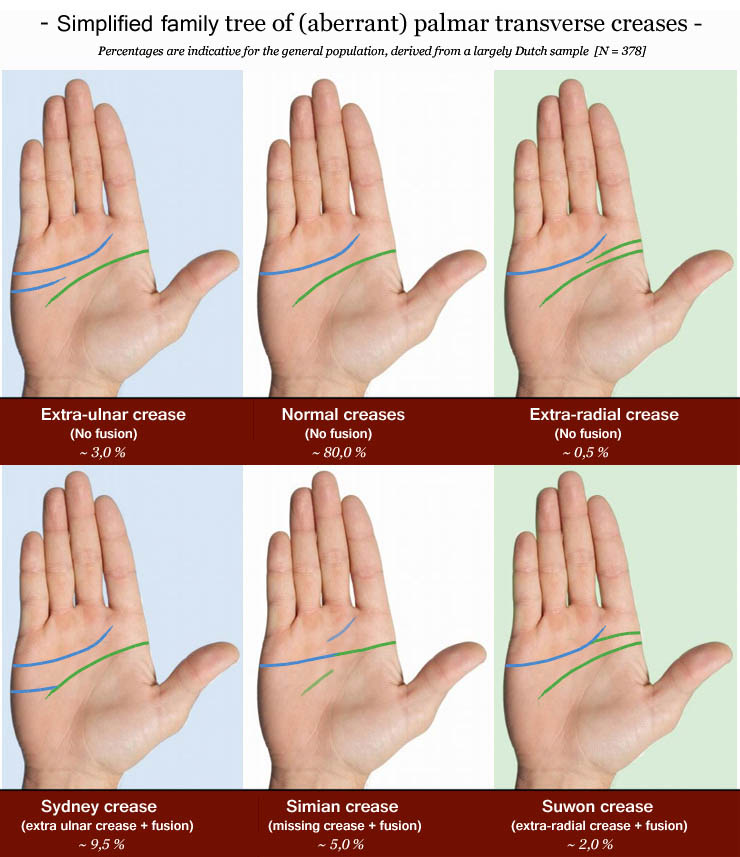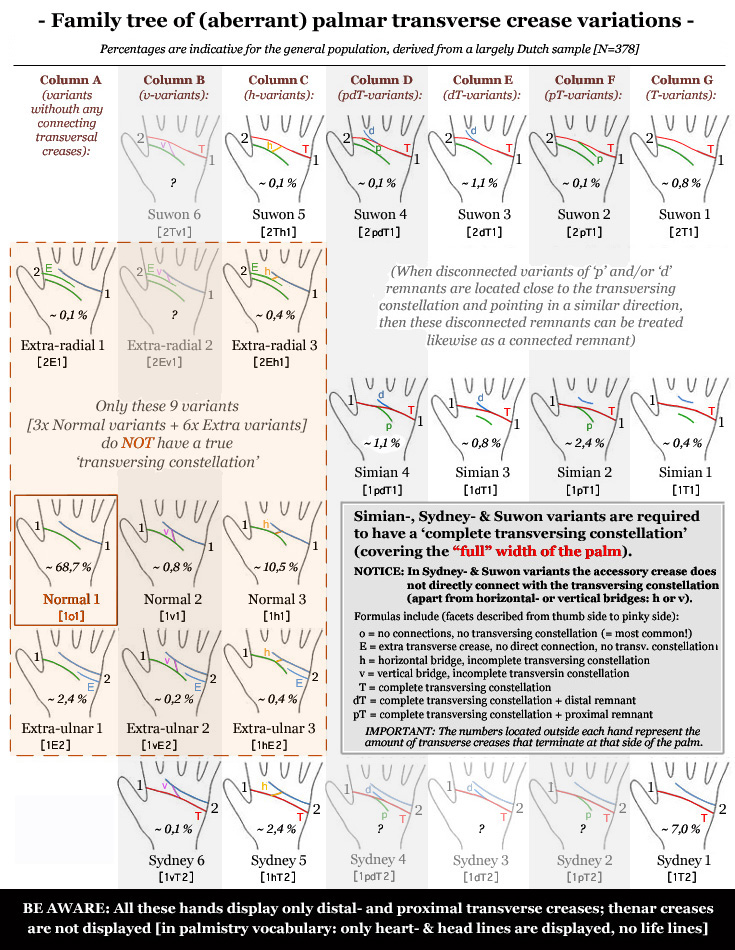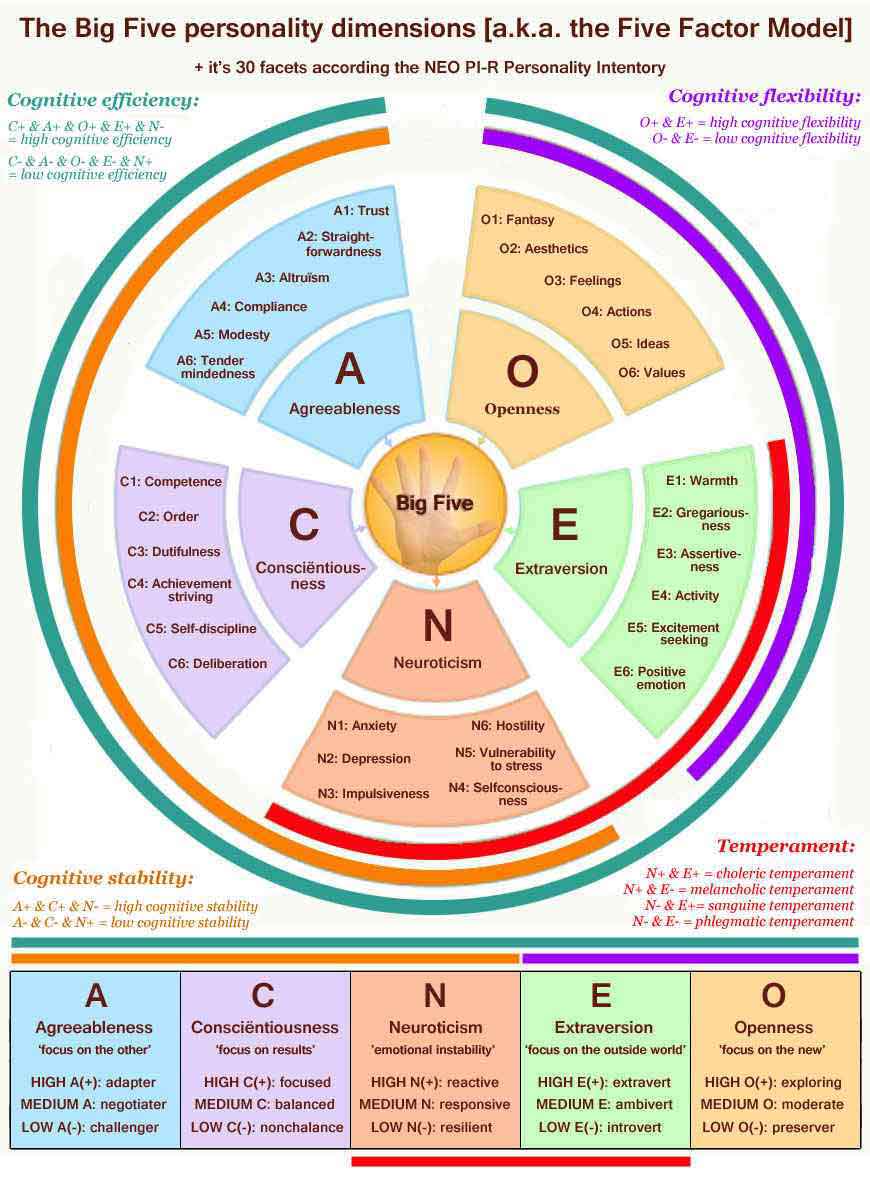|
|
October 8, 2017
Psychodynamic profiles for Simian Line variations
show tendency towards a low 'General Factor of Personality'!
- About the psychological impact of the simian line (a.k.a. single palmar transverse crease) -
The human palm usually presents two major transverse creases, in palmistry these creases are known as the 'heart line' and the 'head line'.
The concept of a simian line / simian crease involves a variation: a fusion of both lines - leaving the typically impression that one of both lines (or at least 'something') appears to be missing. In contemporary science the simian line became known to represent a harmless minor physical anomaly. Even though it is often present with a relatively high prevalence in the most common syndromes and diseases, simian lines can also be observed in the hands of perfectly healthy people (usually with a much lower prevalence). This article presents a peek into the psychological variations of 19 Dutch simian line holders (in the perspective of 243 Dutch controls). Focus is on the psychodynamics involving their self-perceived Big Five personality profiles + it's derived components.
The results show a consistent tendency for simian line holders to score below average for the General Factor of Personality, signaled by a tendency towards low scores for cognitive efficiency [which is associated to represent a major aspect in the concept of '(trait) emotional intelligence']. Additionally, there is also a particularly strong consistent tendency towards a high score for Neuroticism, and in a lesser degree towards a low score for Openness. The picture below presents the psychodynamic profiles for the full simian line population + 7 specific simian line sub-groups.

NOTICE: Profiles displayed in the picture above are based on the performance of 262 subjects on the Dutch version
of the NEO PI-R questionnaire, of which 19 were identified to have a simian line variant.
- What are the most persistent tendencies? -
The most striking result is found involving the derived component 'cognitive efficiency', which involves in this study the summary score of the 5 Big Five dimensions with the dimension Neuroticism attributing in a reversed format (high scores have a low contribution and vice versa).
Simian liners show especially a clear tendency towards low scores for 'cognitive efficiency' - which is also seen in the average scores of all simian line sub-groups (with the strongest effect seen for in the sub-group of simian 1 variants). Regarding the individual scores: 15 out of 19 simian line holders score below the average scores of the control population [N=243]; 2 simian line holders have a score similar to the control average, and only 2 have a score above control average - but both do not belong to the top 25% scorers of the full research population [N=262].
Even though all results reported here are based on self assessments and not on performance, this result is of particular interest because it represents a measure that involves the so-called General Factor of Personality, which became in academic science also recognized to represent a major factor involving the phenomenon of emotional intelligence.
The other 3 derived psychological meta-components show a consistent pattern all attributing to the tendency towards low 'cognitive efficiency' among the simian line people:
they show a moderate tendency for towards low 'cognitive stability', a stronger tendency towards low 'cognitive flexibility' (low average of Openness & Extraversion), and a strong tendency towards a melancholic temperament (which involves the combination of a high score for Neuroticism combined with a low score for Extraversion).
Regarding the Big Five dimensions, by far the strongest tendency is found there for high Neuroticism, where all sub-groups show a consistent score (varying from +10,5% for simian 2 variants to +45,5% for simian 1 variants). Only the results for Conscientiousness can be described show a consistent tendency representing almost perfectly normal scores (varying from -6,7% for simian 4 variants to +3,4% for simian 1 variants).
These results together suggest the simian line population shows a tendency to manifest with relatively high scores for Conscientiousness, but this concerns a tendency that only manifests relative to the other Big Five dimensions + it's derived psychological meta-components. Because there is actually only 1 single simian line sub-group that has managed to produce self-perceived scores for Conscientiousness that are (only) slightly higher than the average of the control population (= the non-simian liners): this involves again the small group that has a simian 1 variant!
- The simian line in palmistry -
According various authors of palmistry books, some common personality features of 'healthy people' that have been associated with the simian line are e.g.:
• 'emotional extremes' (according UK palmists Sasha Fenton  & Malcolm Wright & Malcolm Wright  ); );
• 'individualistic and emotional irregular' (according Japanese palmist Hachiro Asano  ); );
• 'highly introspective' (according Indian palmist V.A.K. Ayer  ); );
• 'egocentricity' (according Indian palm reader K.C. Sen  ); );
• 'difficulty in getting along with others' (according Malaysian palmist Yaschpaule  ); );
• 'intense powers of concentration' (according Canadian palmist Roz Levin  ); );
• 'gift marker' (US hand analyst Richard Unger  ). ).
Even though the vocabulary used by palmistry authors leaves considerable space for free interpretation, the first five personality related adjectives above appear to signal various aspects of the troublesome nature that appears to be involved with simian lines. Only the latter two represent a suggestion that appears to be directed towards some kind of talent.
- CONCLUSION -
The simian line is in general known to have a relatively high prevalence in males and in certain ethnic populations around the world; the prevalence in the general population is described to vary from on just above 1% in white European population to above 10% in various Asian populations.
Even though simian lines can be observed in all healthy populations around the world, in the perspective of medical science the simian line has a high connotation with a very long list of abnormal medical conditions - the most well-known example is Down syndrome (where the prevalence is typically around 40%). Quite some of the medical conditions associated with the simian line are featured with intellectual disabilities, often with an impact for the general IQ in individuals.
Based on a relatively small sample, the present study has revealed that by principle all simian line variations may have an impact for the 'General Factor of Personality' - which can be associated to represent a clue for low '(trait) emotional intelligence', suggesting an impact for the EQ in individuals. Nevertheless, it should be noticed here as well that individual cases do show variations where this tendency is not seen at all (in those people there may be other factors in the hand; clues for which hand factors may be involved are presented in the article: 'Major Hand Signs & the General Factor of Personality').
Finally, it should be noticed that the results do not exclude the possibility that simian lines may actually be present in any 'talented population'; however, the prevalence in those populations can be expected to be below the average of the general population. Nevertheless, the present study does reveal a clue for which aspect of the personality might be involved: results point in the direction of a factor involving relatively high scores for Conscientiousness. However, this latter aspect became only manifest in the perspective of intra-personal behavior because most of the simian line sub-populations did not produce higher scores for Conscientiousness compared to the average of the control population. Therefore, it appears highly recommendable to be very cautious to associate the talents in individual simian liners with their simian line, because it may be possible that they actually have developed their talent(s) despite having a simian line!
10-20-2017 UPDATE: A new study became available describing the impact of the simian line in the perspective of other aberrant transversal crease variations (involing the Sydney line & Suwon line):
- Aberrant Transverse Flexion Creases point towards:'Low Personality Plasticity' (= cognitive inflexibility)
 SUGGESTIONS FOR FURTHER READING: SUGGESTIONS FOR FURTHER READING:
INTRO: The simian line: a minor physical anomaly!
• HOW TO RECOGNIZE Simian Lines?
• WHY THE NAME Simian Line?
• HISTORY of the Simian Line
• ETHNICITY & the Simian Line
• HEALTH & the Simian Line
• PSYCHOLOGY & BEHAVIOR: the Simian Line
• BIG FIVE PROFILING: personality & Simian Line
• PSYCHODYNAMIC PROFILES: the Simian Line
• HAND SIGN TUTOR: Simian Line - quick summary
• FAMOUS PEOPLE with Simian Lines [80+ celebs]
• PROJECTS related to the Simian Line
• ONLINE READINGS for the Simian Line
• SYNONYMS for the Simian Line
Next section:
• Hand Sign Tutor: the simian line!
The illustrations below provide additional insights regarding
the fundamentals of the simian line & the Big Five dimensions + it's derived components

The simplified (above) and advanced (below)
family tree of aberrant palmar transverse creases variations,
including the simian line, Sydney line & Suwon line.

The fundamentals of the Big Five personality dimensions +
it's derived components, featuring: cognitive efficiency, cognitive stability,
cognitive flexibility & temperament.

AGREEABLENESS -
CONSCIENTIOUSNESS -
NEUROTICISM -
EXTRAVERSION -
OPENNESS
|
|
|
|